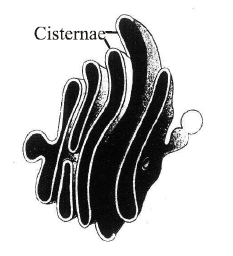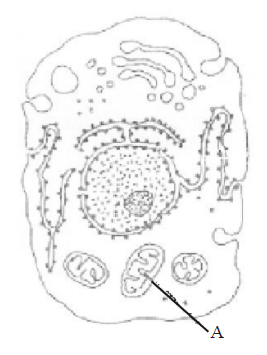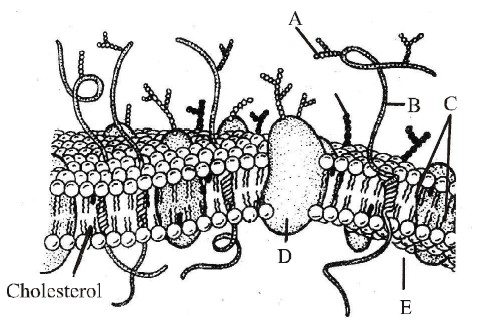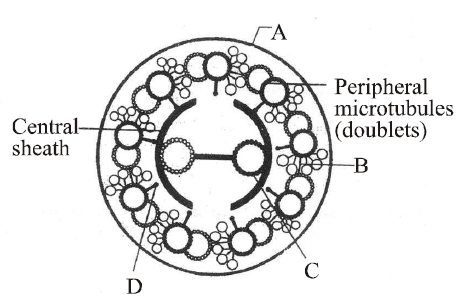Cell - the unit of life MCQ Solved Paper for SSC Stenographer
Thursday 9th of March 2023

Sharing is caring
1. Match column I (cell type) with column II (size) and choose the correct option.
A. A I, B II, C III, D IV
B. A IV, B III, C II, D I
C. A I, B III, C II, D IV
D. A IV, B II, C III, D I
Answer : B
| Column-I | Column-II |
|---|---|
| (Cell type) | (Size) |
| A. Viruses | I. 1-2 ??m |
| B. PPLO | II. 10-20 ??m |
| C. Eukaryotic cell | III. About 0.1 ??m |
| D. Bacterium | IV. 0.02 - 0.2 ??m |
A. A I, B II, C III, D IV
B. A IV, B III, C II, D I
C. A I, B III, C II, D IV
D. A IV, B II, C III, D I
Answer : B
2. The given figures show two types of cell. Which structures are common to both the cells?

A. Nucleus and cell wall
B. Nucleus and cytoplasm
C. Ribosomes and flagella
D. Ribosomes and cell wall
Answer : D

A. Nucleus and cell wall
B. Nucleus and cytoplasm
C. Ribosomes and flagella
D. Ribosomes and cell wall
Answer : D
3. Select the statements which are related to Schwann.
A. Only (i)
B. Only (iii)
C. (i) and (iii)
D. All of these
Answer : D
- He reported that cells have a thin outer layer which is today known as plasma membrane
- Cell wall is a unique character of the plant cell.
- Body of plants and animals are composed of cells and products of cells.
A. Only (i)
B. Only (iii)
C. (i) and (iii)
D. All of these
Answer : D
4. Which one of the following pairs is not correctly matched?
A. Cristae The tubular structure formed by the folding of the inner membrane of the mitochondrion.
B. Plasmodesmata The membrane surrounding the vacuole in plants.
C. Grana Membrane bound discs in chloroplasts that contain chlorophylls and carotenoids.
D. Middle lamella Layer between adjacent cells walls in plants derived from cell plate.
Answer : B
A. Cristae The tubular structure formed by the folding of the inner membrane of the mitochondrion.
B. Plasmodesmata The membrane surrounding the vacuole in plants.
C. Grana Membrane bound discs in chloroplasts that contain chlorophylls and carotenoids.
D. Middle lamella Layer between adjacent cells walls in plants derived from cell plate.
Answer : B
5. Plastids storing fat are called
A. Elaioplasts
B. Sphaerosomes
C. Aleuroplasts
D. Pyrenoids
Answer : A
A. Elaioplasts
B. Sphaerosomes
C. Aleuroplasts
D. Pyrenoids
Answer : A
6. In prokaryotes, chromatophores are
A. specialized granules responsible for colouration of cells
B. structures responsible for organizing the shape of the organism.
C. inclusion bodies lying free inside the cells for carrying out various metabolic activities.
D. internal membrane system which becomes extensive and complex in photosynthetic bacteria.
Answer : D
A. specialized granules responsible for colouration of cells
B. structures responsible for organizing the shape of the organism.
C. inclusion bodies lying free inside the cells for carrying out various metabolic activities.
D. internal membrane system which becomes extensive and complex in photosynthetic bacteria.
Answer : D
7. You are asked to examine a cell using a powerful light microscope. The image you see has a clearly defined nucleus and mitochondria. It also has a large central vacuole and chloroplasts. From what group of organisms did this cell most likely come?
A. Bacteria
B. Protists
C. Fungi
D. Plants
Answer : D
A. Bacteria
B. Protists
C. Fungi
D. Plants
Answer : D
8. Golgi apparatus is absent in
A. higher plants
B. yeast
C. bacteria and blue-green algae
D. None of the above
Answer : C
A. higher plants
B. yeast
C. bacteria and blue-green algae
D. None of the above
Answer : C
9. Study the following statements on cilium or flagellum and answer the question.
Which of the above statements are correct?
A. (i) and (ii)
B. (i), (ii), (iii) and (iv)
C. (i) and (iv)
D. (ii) and (iii)
Answer : B
- Cilium / Flagellum contains an outer ring of nine doublet microtubules surrounding two singlet microtubules.
- Cilia are smaller which work like oars, causing the movement of either the cells or surrounding fluid.
- Flagella are comparatively longer and responsible for cell movement.
- Cilium and flagellum are covered with plasma membrane.
Which of the above statements are correct?
A. (i) and (ii)
B. (i), (ii), (iii) and (iv)
C. (i) and (iv)
D. (ii) and (iii)
Answer : B
10. The fluidity of membranes in a plant in cold weather may be maintained by
A. increasing the number of phospholipids with unsaturated hydrocarbon tails.
B. increasing the proportion of integral proteins.
C. increasing concentration of cholesterol in membrane.
D. increasing the number of phospholipids with saturated hydrocarbon tail.
Answer : A
A. increasing the number of phospholipids with unsaturated hydrocarbon tails.
B. increasing the proportion of integral proteins.
C. increasing concentration of cholesterol in membrane.
D. increasing the number of phospholipids with saturated hydrocarbon tail.
Answer : A
11. Which of the following statements are correct ?
A. (iii) and (iv)
B. (i) and (ii)
C. (ii) and (iii)
D. (i) and (iv)
Answer : A
- In prokaryotic cells, a special membranous structure formed by the extension of the plasma membrane into the cell is known as polysome.
- The smooth endoplasmic reticulum is the major site for synthesis of glycoproteins.
- RuBisCO is the most abundant protein in the whole biosphere.
- Mitochondria, chloroplasts and peroxisomes are not considered as part of endomembrane system. Of the above statements
A. (iii) and (iv)
B. (i) and (ii)
C. (ii) and (iii)
D. (i) and (iv)
Answer : A
12. Identify the cell organelle given below. Which is an important site of formation of glyeoproteins & glycolipids

A. Rough endoplasmic reticulum
B. Smooth endoplasmic reticulum
C. Golgi body
D. mitochondria
Answer : C

A. Rough endoplasmic reticulum
B. Smooth endoplasmic reticulum
C. Golgi body
D. mitochondria
Answer : C
13. Golgi apparatus is concerned with
A. excretion
B. secretion
C. ATP synthesis
D. RNA synthesis
Answer : A
A. excretion
B. secretion
C. ATP synthesis
D. RNA synthesis
Answer : A
14. Axoneme with 9 + 2 microtubular arrangement occurs in
A. cilia
B. flagella
C. both (a) and (b)
D. centriole
Answer : C
A. cilia
B. flagella
C. both (a) and (b)
D. centriole
Answer : C
15. _______________ is the important site of formation of glycoproteins and golycolipids.
A. SER
B. Lysosome
C. Golgi apparatus
D. Mitochondria
Answer : C
A. SER
B. Lysosome
C. Golgi apparatus
D. Mitochondria
Answer : C
16. The cytoskeleton is a proteinaceous network of fibres in the cytoplasm. It is involved in
A. mechanical support.
B. motility.
C. maintenace of cell-shape.
D. all of the above
Answer : D
A. mechanical support.
B. motility.
C. maintenace of cell-shape.
D. all of the above
Answer : D
17. The lipid component of the membrane mainly consists of __________.
A. polysaccharides
B. phosphoglyceride
C. monosaccharaides
D. both (a) and (c)
Answer : B
A. polysaccharides
B. phosphoglyceride
C. monosaccharaides
D. both (a) and (c)
Answer : B
18. In the given figure of animal cell, one orginelle is marked as A. Select the correct identification and function of the organelle A from the given option.

A. Endoplasmic reticulum Synthesis of lipids.
B. Mitochondria Produce cellular energy in the form of ATP.
C. Golgi body Provides packaging material.
D. Lysosomes Secrete hydrolytic enzymes.
Answer : B

A. Endoplasmic reticulum Synthesis of lipids.
B. Mitochondria Produce cellular energy in the form of ATP.
C. Golgi body Provides packaging material.
D. Lysosomes Secrete hydrolytic enzymes.
Answer : B
19. Match column-I with column-II and choose the correct option.
A. A IV; B III; C I; D II
B. A II; B III; C IV; D I
C. A IV; B II; C III; D I
D. A I; B III; C II; D IV
Answer : A
| Column-I | Column-II |
|---|---|
| A. Tonoplast | I. Contain digestive enzyme |
| B. Contractile vacuole | II. Store metabolic gases |
| C. Food vacuole | III. Excretion |
| D. Air vacuole | IV. Transport of ions in plants |
A. A IV; B III; C I; D II
B. A II; B III; C IV; D I
C. A IV; B II; C III; D I
D. A I; B III; C II; D IV
Answer : A
20. Most of water, in mature plant cells occurs in
A. nucleus
B. cell wall
C. vacuoles
D. cytoplasm
Answer : C
A. nucleus
B. cell wall
C. vacuoles
D. cytoplasm
Answer : C
21. The diagram given below represent a filuid mosaic model of plasma membrance. Match the components marked as A, B, C, D and E in the diagram below from the list (i) to (vii).

A. A - (i), B - (ii), C - (iii), D - (iv), E - (v)
B. A - (ii), B - (i), C - (iii), D - (iv), E - (v)
C. A - (i), B - (ii), C - (iii), D - (iv), E - (vi)
D. A - (i), B - (ii), C - (iii), D - (vii), E - (v)
Answer : A

- Sugar
- Protein
- Lipid bilayer
- Integral protein
- Cytoplasm
- Cell wall
- External protein
A. A - (i), B - (ii), C - (iii), D - (iv), E - (v)
B. A - (ii), B - (i), C - (iii), D - (iv), E - (v)
C. A - (i), B - (ii), C - (iii), D - (iv), E - (vi)
D. A - (i), B - (ii), C - (iii), D - (vii), E - (v)
Answer : A
22. Extension of plasma membrane in prokaryotic cell is
A. mesosome
B. haploid
C. ribosome
D. none of these
Answer : A
A. mesosome
B. haploid
C. ribosome
D. none of these
Answer : A
23. Which of these is wrongly matched?
A. Chloroplasts Chlorophyll
B. Elaioplasts Starch
C. Chromoplasts Carotenoids
D. Amyloplasts Carbohydrates
Answer : B
A. Chloroplasts Chlorophyll
B. Elaioplasts Starch
C. Chromoplasts Carotenoids
D. Amyloplasts Carbohydrates
Answer : B
24. According to widely accepted fluid mosaic model cell membranes are semi-fluid, where lipids and integral proteins can diffuse randomly. In recent years, this model has been modified in several respects. In this regard, which of the following statements is incorrect?
A. Proteins in cell membranes can travel within the lipid bilayer.
B. Proteins can also undergo flip-flop movements in the lipid bilayer.
C. Proteins can remain confined within certain domains of the membrane.
D. Many proteins remain completely embedded within the lipid bilayer.
Answer : B
A. Proteins in cell membranes can travel within the lipid bilayer.
B. Proteins can also undergo flip-flop movements in the lipid bilayer.
C. Proteins can remain confined within certain domains of the membrane.
D. Many proteins remain completely embedded within the lipid bilayer.
Answer : B
25. A component of cytoskeleton is
A. microtubule
B. bone
C. chitin
D. cartilage.
Answer : A
A. microtubule
B. bone
C. chitin
D. cartilage.
Answer : A
26. The best material for study of structure of cell membrane is
A. RBC of human
B. RBC of frog
C. cheek cell of human
D. liver cell of rat
Answer : A
A. RBC of human
B. RBC of frog
C. cheek cell of human
D. liver cell of rat
Answer : A
27. Plastids are found in
A. all animal cells.
B. some animal cells.
C. all plant cells.
D. all plant cells and euglenoides.
Answer : D
A. all animal cells.
B. some animal cells.
C. all plant cells.
D. all plant cells and euglenoides.
Answer : D
28. Read the folowing statements and identify the correct option.
A. (i) and (ii)
B. (ii) and (iv)
C. (i), (ii) and (iv)
D. None of the above
Answer : C
- Contractile vacuole takes part in osmoregulation and excretion.
- Food vacuole is formed by engulfing the food particles.
- The vacuole is bound by a double membrane called tonoplast.
- Vacuole can occupy upto 90 percent of the volume of the cell.
A. (i) and (ii)
B. (ii) and (iv)
C. (i), (ii) and (iv)
D. None of the above
Answer : C
29. Match column-I with column-II and select the correct option.
A. A - IV, B - V, C - I, D - II
B. A - I, B - II, C - IV, D - III
C. A - IV, B - I, C - II, D - III
D. A - I, B - II, C - III, D - IV
Answer : A
| Column - I | Column - II |
|---|---|
| A. Golgi apparatus | I. Storage |
| B. Mitochondria | II. Photosynthesis |
| C. Vacuoles | III. Transport |
| D. Grana | IV. Secretion |
| .. | V. Respiration |
A. A - IV, B - V, C - I, D - II
B. A - I, B - II, C - IV, D - III
C. A - IV, B - I, C - II, D - III
D. A - I, B - II, C - III, D - IV
Answer : A
30. Match column-I (cell organelle) with column-II membrane and select the correct option from the codes given below.
A. A - I, B - II, C - III
B. A - III, B - I, C - II
C. A - III, B - II, C - I
D. A - II, B - III, C - I
Answer : C
| Column-I | Column-II |
|---|---|
| A. Mitochondria | I. Without membrane |
| B. Lysosomes | II. Single membrane |
| C. Ribosomes | III. Double membrane |
A. A - I, B - II, C - III
B. A - III, B - I, C - II
C. A - III, B - II, C - I
D. A - II, B - III, C - I
Answer : C
31. Polysome is a chain of
A. oxysomes
B. sphaerosomes
C. ribosomes
D. dictyosomes
Answer : C
A. oxysomes
B. sphaerosomes
C. ribosomes
D. dictyosomes
Answer : C
32. pH of vacuolar cell sap is
A. neutral and isotonic.
B. alkaline and isotonic.
C. acidic and hypertonic.
D. equal to cytoplasm and isotonic.
Answer : C
A. neutral and isotonic.
B. alkaline and isotonic.
C. acidic and hypertonic.
D. equal to cytoplasm and isotonic.
Answer : C
33. In which method of transport, plasma membrane does not require carrier molecule?
A. Active transport
B. Facilitated diffusion
C. Simple diffusion
D. Na+/sup> K+ pump
Answer : C
A. Active transport
B. Facilitated diffusion
C. Simple diffusion
D. Na+/sup> K+ pump
Answer : C
34. Which of the following statement is correct regarding vacuole?
A. It is membrane-bound and contains storage proteins and lipids.
B. It is membrane-bound and contains water and excretory substances.
C. It lacks membrane and contains air.
D. It lacks membrane and contains water and excretory substances.
Answer : B
A. It is membrane-bound and contains storage proteins and lipids.
B. It is membrane-bound and contains water and excretory substances.
C. It lacks membrane and contains air.
D. It lacks membrane and contains water and excretory substances.
Answer : B
35. Identify the components labelled A, B, C and D in the given section of cilia/flagella showing different parts. Choose the option which shows the correct labelling of parts.

A. A Plasma membrane, B Interdoublet bridge, C Central microtubule, D Radial spoke
B. A Plasma membrane, B Arm, C Central microtubule, D Radial spoke
C. A Plasma membrane, B Interdoublet bridge, C Hub, D Radial spoke
D. A Plasma membrane, B Interdoublet bridge, C Hub, D Arm
Answer : A

A. A Plasma membrane, B Interdoublet bridge, C Central microtubule, D Radial spoke
B. A Plasma membrane, B Arm, C Central microtubule, D Radial spoke
C. A Plasma membrane, B Interdoublet bridge, C Hub, D Radial spoke
D. A Plasma membrane, B Interdoublet bridge, C Hub, D Arm
Answer : A
36. The cell theory was given in year 1839 by Schleiden and Schwann. According to this theory all organisms are composed of cell and cells are the basic unit of life.
How did this theory help in the field of science?
A. It helped to study the working of cells.
B. It helped in curing diseases caused by cell.
C. It helped in restating the earlier theories on cell.
D. It helped in introducing the use of microscopes to study cell.
Answer : A
How did this theory help in the field of science?
A. It helped to study the working of cells.
B. It helped in curing diseases caused by cell.
C. It helped in restating the earlier theories on cell.
D. It helped in introducing the use of microscopes to study cell.
Answer : A
37. Protein synthesis in an animal cell occurs
A. on ribosomes present in cytoplasm as well as in mitochondria.
B. on ribosomes present in the nucleolus as well as in cytoplasm.
C. only on ribosomes attached to the nuclears envelope and endoplasmic reticulum.
D. only on the ribosomes present in cytosol.
Answer : A
A. on ribosomes present in cytoplasm as well as in mitochondria.
B. on ribosomes present in the nucleolus as well as in cytoplasm.
C. only on ribosomes attached to the nuclears envelope and endoplasmic reticulum.
D. only on the ribosomes present in cytosol.
Answer : A
38. Microtubules are absent in
A. mitochondria
B. centriole
C. flagella
D. spindle fibres
Answer : A
A. mitochondria
B. centriole
C. flagella
D. spindle fibres
Answer : A
39. Both the membranes of mitochondrion are
A. structurally different but functionally similar.
B. structurally as well as functionally different.
C. structurally similar but functionally different.
D. structurally different but functionally similar.
Answer : B
A. structurally different but functionally similar.
B. structurally as well as functionally different.
C. structurally similar but functionally different.
D. structurally different but functionally similar.
Answer : B
40. Choose the incorrect match.
A. Nucleus RNA
B. Lysosome Protein synthesis
C. Mitochondria Respiration
D. Cytoskeleton Microtubules
Answer : B
A. Nucleus RNA
B. Lysosome Protein synthesis
C. Mitochondria Respiration
D. Cytoskeleton Microtubules
Answer : B
41. Satellite means
A. terminal part of the chromosome beyond secondary constriction.
B. terminal part of the chromosome beyond primary constriction.
C. terminal part of chromosome beyond tertiary constriction.
D. none of the above
Answer : A
A. terminal part of the chromosome beyond secondary constriction.
B. terminal part of the chromosome beyond primary constriction.
C. terminal part of chromosome beyond tertiary constriction.
D. none of the above
Answer : A
42. Which of the following will determines the shape of the cells and provides a strong structural support to prevent the bacterium from bursting or collapsing?
A. Plasmids
B. Cell wall
C. Mesosome
D. Cell membrane
Answer : B
A. Plasmids
B. Cell wall
C. Mesosome
D. Cell membrane
Answer : B
43. Which of the following pair are correctly matched.
A. Microtubules Structural components of cilia
B. Centrioles Store hydrolytic enzymes
C. Amyloplasts Store oil protein and starch in plants
A. A, B and C
B. A and B
C. A
D. A and C
Answer : C
A. Microtubules Structural components of cilia
B. Centrioles Store hydrolytic enzymes
C. Amyloplasts Store oil protein and starch in plants
A. A, B and C
B. A and B
C. A
D. A and C
Answer : C
44. Membranous extensions in blue green algae are known as
A. phytochrome
B. chromatophore
C. mesosome
D. pneumatophore
Answer : B
A. phytochrome
B. chromatophore
C. mesosome
D. pneumatophore
Answer : B
45. Centrioles and centrosomes occur in the cells of
A. green plants
B. animals
C. bacteria and cyanobacteria
D. both (b) and (c)
Answer : B
A. green plants
B. animals
C. bacteria and cyanobacteria
D. both (b) and (c)
Answer : B
46. Which of the following statements are correct?
A. Na+/K+ pump is an example of active transport.
B. In plant cells lipid like steroidal hormones are synthesized in SER.
C. In plant cells, the vacuoles can occupy up to 10% of the volume of the cell.
D. Chlorophyll and leucoplast are responsible for trapping light energy essential for photosynthesis.
Answer : A
A. Na+/K+ pump is an example of active transport.
B. In plant cells lipid like steroidal hormones are synthesized in SER.
C. In plant cells, the vacuoles can occupy up to 10% of the volume of the cell.
D. Chlorophyll and leucoplast are responsible for trapping light energy essential for photosynthesis.
Answer : A
47. Given below are some characters of a cell organelle identify the correct organelle which shows all the characters described above.
A. Golgi apparatus
B. Lysosomes
C. Endoplasmic reticulum
D. Vacuoles
Answer : D
- It is a membrane bound space found in the cytoplasm.
- It is bound by a single membrane called tonoplast.
- It contains water, sap, excretory products and other materials not useful to the cell.
- It has higher concentration of sap than the cytoplasm.
A. Golgi apparatus
B. Lysosomes
C. Endoplasmic reticulum
D. Vacuoles
Answer : D
48. Match column-I with column-II and select the correct option.
A. A III, B II, C IV, D I
B. A II, B III, C IV, D I
C. A I, B III, C II, D IV
D. A IV, B II, C III, D I
Answer : A
| Column - I | Column - II |
|---|---|
| A. RER | I. Intracellular and extracellular digestion |
| B. Cell wall | II. Provide structural support to the cell |
| C. Flagella | III. Protein synthesis and secretion |
| D. Lysosomes | IV Responsible for cell movement |
A. A III, B II, C IV, D I
B. A II, B III, C IV, D I
C. A I, B III, C II, D IV
D. A IV, B II, C III, D I
Answer : A
49. Active transport differs from passive transport in that active transport
A. requires energy.
B. always requires input of ATP.
C. moves molecules against a concentration gradient.
D. both (a) and (c)
Answer : D
A. requires energy.
B. always requires input of ATP.
C. moves molecules against a concentration gradient.
D. both (a) and (c)
Answer : D
50. What would happen if lysosomes get ruptured in a cell?
A. Cell dies
B. Cell shrinks
C. Cell swell up
D. Nothing would happen
Answer : A
/div> A. Cell dies
B. Cell shrinks
C. Cell swell up
D. Nothing would happen
Answer : A
Sharing is caring
Related Post
Strength of Materials MCQ Solved Paper for SSC GD
Morphology of flowering plants MCQ Solved Paper for SSC JE
Tumors of the prostate MCQ Solved Paper for UPSC CDS
1000+ Current Affairs February 2023 MCQ for ESIC [Solved]
1000+ State of Matter MCQ for UPSC CDS [Solved]
UPSC CSE - Asp Programming 1000+ MCQ [Solved] PDF Download